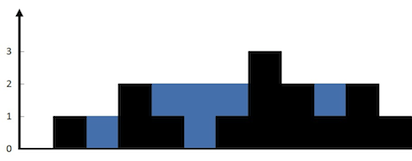本文主要是介绍力扣labuladong——一刷day61,希望对大家解决编程问题提供一定的参考价值,需要的开发者们随着小编来一起学习吧!
提示:文章写完后,目录可以自动生成,如何生成可参考右边的帮助文档
文章目录
- 前言
- 一、力扣865. 具有所有最深节点的最小子树
- 二、力扣1123. 最深叶节点的最近公共祖先
- 三、力扣1026. 节点与其祖先之间的最大差值
- 四、力扣1120. 子树的最大平均值
前言
二叉树的递归分为「遍历」和「分解问题」两种思维模式,这道题需要用到「分解问题」的思维,而且涉及处理子树,需要用后序遍历
一、力扣865. 具有所有最深节点的最小子树
/*** Definition for a binary tree node.* public class TreeNode {* int val;* TreeNode left;* TreeNode right;* TreeNode() {}* TreeNode(int val) { this.val = val; }* TreeNode(int val, TreeNode left, TreeNode right) {* this.val = val;* this.left = left;* this.right = right;* }* }*/
class Solution {public TreeNode subtreeWithAllDeepest(TreeNode root) {Result res = fun(root);return res.node;}public Result fun(TreeNode root){if(root == null){return new Result(null,0);}Result left = fun(root.left);Result right = fun(root.right);if(left.depth == right.depth){return new Result(root,left.depth+1);}Result res = left.depth > right.depth ? left : right;res.depth = res.depth + 1;return res;}
}
class Result{public TreeNode node;public int depth;public Result(TreeNode node, int depth){this.node = node;this.depth = depth;}
}
二、力扣1123. 最深叶节点的最近公共祖先
/*** Definition for a binary tree node.* public class TreeNode {* int val;* TreeNode left;* TreeNode right;* TreeNode() {}* TreeNode(int val) { this.val = val; }* TreeNode(int val, TreeNode left, TreeNode right) {* this.val = val;* this.left = left;* this.right = right;* }* }*/
class Solution {public TreeNode lcaDeepestLeaves(TreeNode root) {Result res = fun(root);return res.node;}public Result fun(TreeNode root){if(root == null){return new Result(null,0);}Result left = fun(root.left);Result right = fun(root.right);if(left.depth == right.depth){return new Result(root,left.depth+1);}Result res = left.depth > right.depth ? left : right;res.depth = res.depth + 1;return res;}
}
class Result{public TreeNode node;public int depth;public Result(TreeNode node, int depth){this.node = node;this.depth = depth;}
}
三、力扣1026. 节点与其祖先之间的最大差值
/*** Definition for a binary tree node.* public class TreeNode {* int val;* TreeNode left;* TreeNode right;* TreeNode() {}* TreeNode(int val) { this.val = val; }* TreeNode(int val, TreeNode left, TreeNode right) {* this.val = val;* this.left = left;* this.right = right;* }* }*/
class Solution {int res = 0;public int maxAncestorDiff(TreeNode root) {fun(root);return res;}public int[] fun(TreeNode root){if(root == null){return new int[]{Integer.MAX_VALUE,Integer.MIN_VALUE};}int[] leftMinMax = fun(root.left);int[] rightMinMax = fun(root.right);int curMin = Math.min(Math.min(leftMinMax[0],rightMinMax[0]),root.val);int curMax = Math.max(Math.max(leftMinMax[1],rightMinMax[1]),root.val);res = Math.max(res,Math.max(curMax - root.val, root.val - curMin));return new int[]{curMin,curMax};}
}
四、力扣1120. 子树的最大平均值
/*** Definition for a binary tree node.* public class TreeNode {* int val;* TreeNode left;* TreeNode right;* TreeNode() {}* TreeNode(int val) { this.val = val; }* TreeNode(int val, TreeNode left, TreeNode right) {* this.val = val;* this.left = left;* this.right = right;* }* }*/
class Solution {double res = 0;public double maximumAverageSubtree(TreeNode root) {fun(root);return res;}public double[] fun(TreeNode root){if(root == null){return new double[]{0,0};}double[] left = fun(root.left);double[] right = fun(root.right);double curCount = left[0] + right[0] + 1;double curSum = left[1] + right[1] + root.val;res = Math.max(res,curSum/curCount);if(curCount == 1){return new double[]{curCount,root.val};}return new double[]{curCount,curSum};}
}
这篇关于力扣labuladong——一刷day61的文章就介绍到这儿,希望我们推荐的文章对编程师们有所帮助!









